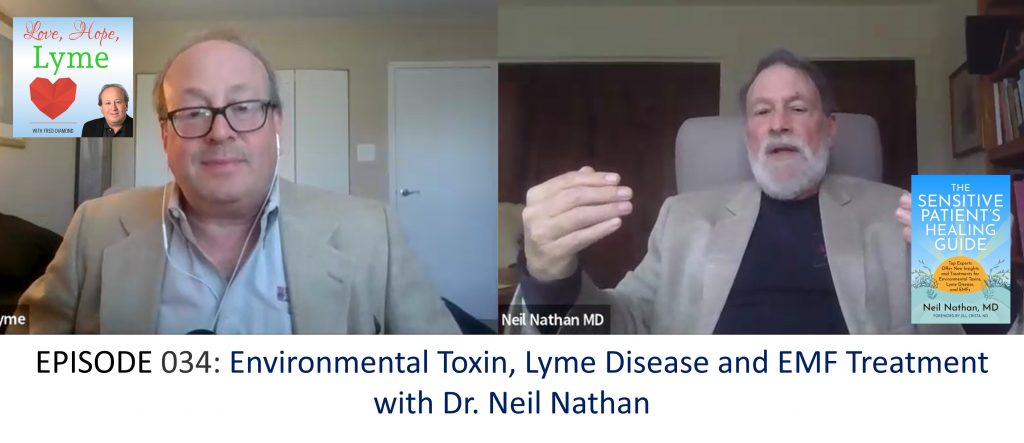PODCAST: Dr. Neil Nathan on mold, Lyme, and EMFs

By Fred Diamond
When I wrote my book “Love, Hope, Lyme: What Family Members, Partners, and Friends Who Love a Chronic Lyme Survivor Need to Know,” I knew that many Lyme survivors also struggled with mold.
I did not, however, know about other sensitivities that they might also have to deal with such as electromagnetic frequencies (EMFs), mast cell activation (MCAS), and heavy metals.
On the latest Love, Hope, Lyme Podcast, Dr. Neil Nathan, author of “The Sensitive Patient’s Healing Guide: Top Experts Offer New Insights and Treatments for Environmental Toxins, Lyme Disease, and EMFs,” discusses them in detail.
I first discovered Dr. Nathan’s work on helping mold sufferers in his book “Toxic.”
Reflecting on his long career, Nathan notes a striking shift in his practice: “When I first started out, I didn’t know that I saw very many patients who were very sensitive. But as the world evolved and as my practice evolved, I began to notice that I had more and more patients who had become sensitive to almost everything.”
These patients, whom he describes as “canaries in the coal mines,” experience sensitivities to light, sound, touch, food, chemicals, and EMFs. Nathan observed that “almost every patient I saw was so sensitive.” He emphasizes that this isn’t just a localized issue, stating, “I think this is a global phenomenon.”
An epidemic concern
Nathan believes there’s an epidemic of sensitivity and asserts, “There are literally millions of people now who have become sensitized who need help.” He collaborated with 20 experts in the field to create this book, ensuring that readers benefit from a variety of insights. He assures those struggling with sensitivity, “This is not in your head. This is very real, and we know how to treat it.”
When discussing Bartonella, Nathan describes it as “a bacteria that gets into our bodies,” often referred to as a stealth infection due to its ability to hide from the immune system. He explains that Bartonella can hide by going intracellular, meaning it actually burrows into a cell. This bacteria can be transmitted through tick bites, flea bites, and even cat scratches.
Nathan warns, “About 40% of the ticks in the United States, depending on region, carry Bartonella.” Despite its challenges, he highlights the advancements in treatment, especially noting Dr. Richard Horowitz’s Dapsone protocols, which have “profoundly improved our results from treating Bartonella.”
Bartonella, a common tick-borne co-infection, can present symptoms similar to Lyme disease, such as systemic inflammation. Nathan lists common symptoms: fatigue, cognitive impairment, headaches, joint pain, and more specifically for Bartonella, pain on the bottom of the feet resembling plantar fasciitis, and unusual rashes.
He stresses that many physicians still don’t understand these infections, often misdiagnosing them as psychological issues. Nathan is clear: “This is a bacterial infection that can be treated.”
Mold and MCAS
He also draws attention to mold toxicity, stating, “Mold toxicity is at least as common as Lyme disease, maybe more common, and has the same symptoms.” The interaction between mold and Lyme is crucial, as both “weaken the immune system to the point that you become susceptible to the others.”
Addressing the source of mold exposure, Nathan clarifies that it’s “about exposure to water-damaged buildings” rather than food. While acknowledging the controversy, he asserts, “We’re getting it from the air in moldy buildings.”
Nathan advises those with Lyme to consider mold as a potential factor in their symptoms. Nathan explains the concept of the “trifecta of sensitivity,” which includes the limbic system, the vagal system, and mast cell activation.
He stresses, “The body cannot heal if it doesn’t feel safe.” He describes the limbic system as controlling “emotion and sensitivity,” and when it’s impaired, symptoms like sensitivity to light, sound, chemicals, and mood swings can occur.
The vagal system, centered around the vagus nerve, is another component.
Nathan highlights its role in regulating the autonomic nervous system and its influence on symptoms like intestinal motility, palpitations of the heart, shortness of breath, and POTS. He emphasizes that the symptoms are not psychological but neurological and can be addressed through specific treatments.
Mast cell activation (MCAS), the third part of the trifecta, is common in those exposed to mold and Lyme. Nathan mentions that “any symptom that shows up while you start to eat or within 15, 20 minutes of eating” could indicate mast cell activation. Despite inadequate tests, Nathan reassures patients that it is treatable, urging them to consider it if they have persistent symptoms.
EMFS and heavy metals
Nathan also discusses EMF toxicity, noting its increased prevalence with the shift to 5G technology. He describes common symptoms such as cognitive impairment, headaches, and fatigue.
He emphasizes that EMF sensitivity is real, despite skepticism from others. He advocates for understanding and addressing these sensitivities rather than dismissing them.
Heavy metals, such as mercury and lead, are another concern. Nathan warns that “heavy metals all have a predisposition for being absorbed or working in one particular tissue,” leading to various health issues. He encourages testing and treatment for heavy metal exposure, highlighting its role in chronic illness.
Nathan focuses on educating physicians about chronic inflammatory illnesses. He states, “We need more doctors doing this,” emphasizing the importance of spreading knowledge and training future physicians to handle these complex conditions.
Nathan concludes with a message of hope: “If you have not been helped so far, do not give up. Find someone who knows what they’re doing and get the help that you need. We now know enough that we really can help most people, so hang in there.”
Click here to listen to all episodes of the Love, Hope, Lyme Podcast or on YouTube.
Fred Diamond is based in Fairfax, Virginia and can be contacted via Facebook. His popular book, “Love, Hope, Lyme: What Family Members, Partners, and Friends Who Love a Chronic Lyme Survivor Need to Know” is available on Amazon. The e-version of the book is always free to Lyme survivors. PM Fred on Facebook for your copy.





















We invite you to comment on our Facebook page.
Visit LymeDisease.org Facebook Page